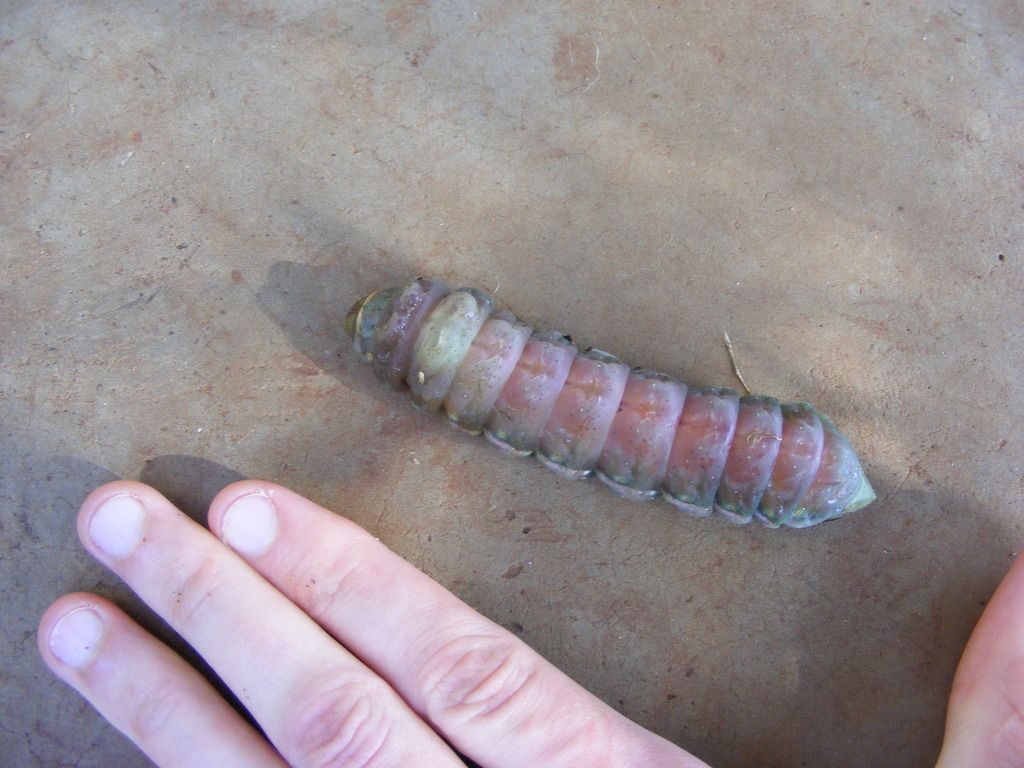|
|
Post by cabintom on Jun 15, 2015 6:26:00 GMT -8
This was found crawling across the lawn here at the inn in Kampala. I'm assuming it's a beetle larva (I can't imagine a moth being this large), and am wondering if anyone can help narrow down the identification? (Also, how would I know if it's ready to pupate? And what sort of housing should I be keeping it in?) Thanks in advance! Tom    |
|
|
|
|
|
Post by africaone on Jun 15, 2015 6:44:13 GMT -8
it is a saturniidae larva probbaly of the genus Lobobunaea (may be phaedusa) at the prepupal stage just before entering the soil to pupate. It becomes with a violet color at this stage (normally it is green)
|
|
|
|
Post by Adam Cotton on Jun 15, 2015 8:35:42 GMT -8
Interesting, I didn't know that some Saturniids pupate underground. I suppose I shouldn't be too surprised, as there are even some Papilionids that pupate underground too.
Adam.
|
|
|
|
Post by cabintom on Jun 15, 2015 11:10:19 GMT -8
it is a saturniidae larva probbaly of the genus Lobobunaea (may be phaedusa) at the prepupal stage just before entering the soil to pupate. It becomes with a violet color at this stage (normally it is green) Merci!! I never imagined Saturniidae larva being so large! I better put more soil in the container then. Anything else I should know in terms of care? Tom |
|
|
|
Post by Adam Cotton on Jun 15, 2015 13:09:34 GMT -8
Tom, A final instar larva of Attacus atlas is much larger than that, comparing the larva with your hand. Of course, you may possibly have much larger than normal hands.  By the way, it couldn't be a beetle larva as they don't have abdominal prolegs. Adam. |
|
|
|
Post by africaone on Jun 15, 2015 22:23:35 GMT -8
L. phaedusa is one the largest moth in Africa. It has a big abdomen then larva is bigger than i.e. Epiphora, of the same wingspan, that have small abdomen.
it is an edible Caterpillar.
The all tribe of Bunaeini (African) are underground (or similar) pupating. Many Urotini too. They are making a very thin and fragile cocoon that is just a "clean" chamber that retain the soil to allow pupating safely. Few African saturniidae spin real cocoon (Epiphora, Argema that are of Tribes existing also outside Africa) and some others (Tribe Ludiini) spin cocoon with large mesh, on the soil (between small branches and dried leaves). the genus Pseudantheraea spins light cocoon with extremely large mesh in the vegetation.
|
|
|
|
|
|
Post by cabintom on Jun 15, 2015 22:37:49 GMT -8
It buried itself last night and I haven't seen it since, so I assume it has pupated. How long until it ecloses? How should I be storing the container?
|
|
|
|
Post by africaone on Jun 15, 2015 22:54:46 GMT -8
let it without any disturb at least 2 weeks (10 days is normally enough for pupation), after you can check inside the soil to get the pupa, solidified and tough nearly black. You will see, if not destroyed, the very thin cocoon that covers the pupating chamber and the rest of skin.
The adult will emerge some weeks later duration may vary from 3-4 weeks to some months depending diapause.
You can know date of emergence 24 hours before as the cuticule become soft, but be careful as it becomes very fragile and if you break the cuticule the adult will not emerge or will badly devellop his wings. Don't do it if you are not sure as it is really dangerous to do it without precaution.
|
|
|
|
Post by cabintom on Jun 16, 2015 1:27:11 GMT -8
Great! Hopefully I can see this through until emergence.  |
|